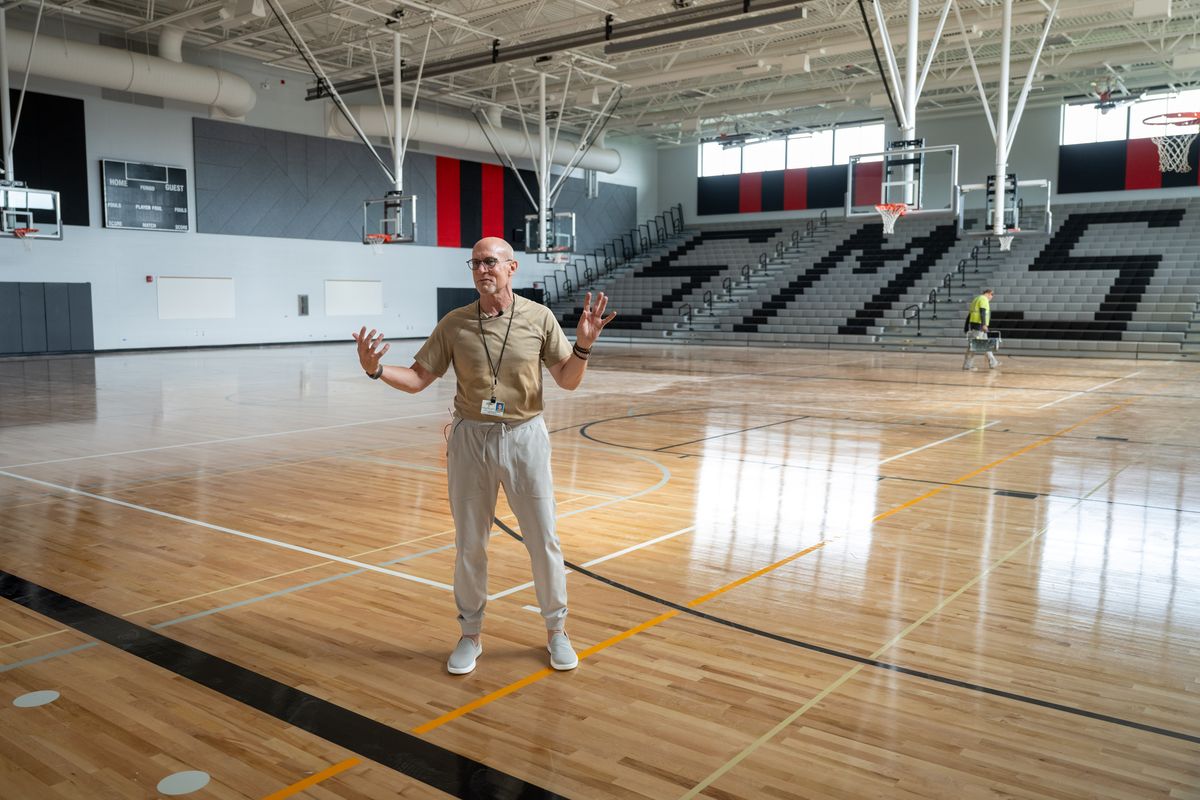Get ready, Thunderbirds: Freshly reconstructed Sacajawea Middle School to open next month

After a $78 million facelift, the new Sacajawea Middle School is post-op and ready for its first group of nearly 1,000 students with the start of school in two weeks.
The new building replaces the now-demolished red brick school built in 1959. The replacement project was funded through a bond approved by voters in 2018, a package that paid for the building and replacement of six middle schools, among other facility improvements, to make way for the recent incorporation of sixth graders into middle school at Spokane Public Schools.
While the new Sacajawea nods to its predecessor with red brick incorporated in the design, the buildings’ similarities end there.
The new school is a two-story giant, with floor-to-ceiling windows allowing light to stream into classrooms, offices and common areas such as the school’s open “nutritional commons” and “learning commons.” Rebranded versions of a cafeteria and library, respectively, these spaces are intended to be used freely by students.
“The intention is to give them back to the students,” said Greg Forsyth, capital projects administrator at Spokane Public Schools. “What that means is, ‘Hey, this is yours. Come on in, use it.’ ”
Adjacent to the commons are learning stairs, another gathering space for students to eat lunch, watch presentations or just kick up their feet and socialize.
Classes for electives including art, photography and wood shop have large windows facing the common areas so students can watch their peers pursuing these endeavors, whetting their appetite to try themselves.
“Those type of classrooms that broaden a student’s understanding and hopefully inspire them, someday they might go deeper into at high school,” Forsyth said.
Meandering through the new Sacajawea, it’s clear there’s something missing from other schools.
“We don’t have hallways anymore. We have spaces where students gather,” Forsyth said.
The commons and stairs aren’t the only non-prescribed places for students to make themselves comfortable. The school has six neighborhoods, each with four classrooms, a lab and a general purpose huddle room, all circling yet another common area equipped with cushy chairs for kids to kick back.
“We need our students to be comfortable,” Forsyth said. “Students will sit on the floor before they sit in a hard chair.”
Emphasizing flexibility, the neighborhoods can either be sorted by subject or grade level, based on building leadership’s discretion. Classrooms form culs-de-sac around the students’ leisure spaces with large windows so staff can keep a watchful eye on students even when they’re not in class.
“We call that passive supervision,” Forsyth said.
“Before, we had long long corridors with doors that all shut. Nobody knew what was going on outside of their classroom doors, but now we know.”
Alumni of the school may notice the absence of an iconic totem pole that once loomed outside the entrance of the old building. Installed in the 1980s, the wooden statue has seen better days, according to district spokesperson Ryan Lancaster. They don’t know if they’ll incorporate the pole into the new building, but have “carefully preserved” it in storage.
The woman behind the wheel
The new building’s inaugural principal, Tracey Leyde, has worked in the district for over 20 years serving different roles, but only ever at Sacajawea or Lewis and Clark High School, into which Sacajawea students feed.
She’s ready to greet the first flock of thunderbirds when school starts in September, but still mourns the demolition of the building she worked in for decades and the memories made there, especially with some staff members who have since died.
“It’s the people that were there that are gone now. That place held those memories,” she said.
John Oakley, teacher and baseball coach at Sacajawea who died in 2016 after 28 years working at the district, is among those memories. Pat Fiorillo died in 2012 after 23 years teaching and coaching at Sacajawea.
“That’s the thing about Sac,” she said. “The teachers don’t go anywhere, they live their entire career here.”
Leyde is eager and stressed for the undertaking of a brand-new building, a blank slate with unforeseen challenges and opportunities that will present themselves as students break in the building.
“I knew how to make that other building work, I’m not quite sure yet how to make this one work,” she said.
Though she said she knows there will be “tweaks,” Leyde will continue her mission of centering the students in their academic success at the helm of her new school. When the ribbon is cut on the first day of school, Leyde will have her eye on the ball.
“We never drop the kid ball, is how I would say it,” she said. “Always make sure the priority is always, what do I need to do to make sure I’m helping kids and putting them first.”